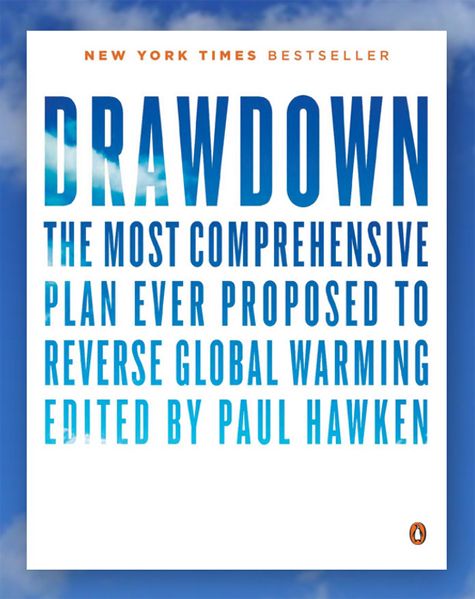
Drawdown / Penguin Press
Whether you are looking for a unique book to give as a gift or just one for yourself to delve into, we have some options. Here’s THE DIRT‘s top 10 books of 2017, our picks for the best on the environment, cities, and landscape:
Drawdown: The Most Comprehensive Plan Ever Proposed to Reverse Global Warming (Penguin Press, 2017)
Author and environmental activist Paul Hawken assembled hundreds of experts around the world to rank the potential positive impacts of 100 substantive climate solutions. One of the most accessible and informative books on climate change, Drawdown makes clear the vital role of landscape architecture, architecture, and urban planning in finding a way to reduce greenhouse gas emissions. Hawken and his coalition consider complete streets and bicycle infrastructure, walkable cities, green roofs, composting systems, and net-zero buildings as critically important. Other top solutions — like educating girls in developing countries and silvopasture — will cause you to think more about the relationships between population, agriculture, and sustainability.
Be Seated (Applied Research and Design Publishing, 2017)
In his new book, Laurie Olin, FASLA, founder of the landscape architecture firm OLIN and this year’s Vincent Scully Prize winner, brings to life his deep interest in outdoor seating. As he describes: “My interest in public outdoor seating in parks and plazas revolves around two poles: one is related to the fascination that Emerson and other philosophers have shown regarding aspects of the quotidian in our lives and experience, its pressures and benefits; the other is the utility of public seating in guiding our conduct as citizens.” Scattered throughout are evocative sketches and water-colors and well-curated images. If you enjoy trying to figure out what makes a public space great, you’ll love this book.
Richard Rothstein, an authority on housing policy, “explodes the myth that America’s cities came to be racially divided through de facto segregation―that is, through individual prejudices, income differences, or the actions of private institutions like banks and real estate agencies. Rather, The Color of Law incontrovertibly makes clear that it was de jure segregation―the laws and policy decisions passed by local, state, and federal governments―that actually promoted the discriminatory patterns that continue to this day.” As American cities continue to address the legacy of segregation while also dealing with widespread gentrification, this new look at urban history is invaluable.
Ashley Dawson, a professor of English at the City University of New York, argues that mega-cities, which are most often found on coasts, are “ground zero for climate change,” given they are home to our largest populations, highly vulnerable, and also contribute the most to greenhouse gas emissions. Reviewing Extreme Cities, author McKenzie Wark writes: “Dawson shows how social movements have combined action on disaster relief with forms of equitable common life to produce models for radical adaptation from which we can all learn. This is a brilliant summation of what we know and what we can do to build a new kind of city in the ruins of the old.”
Handbook of Biophilic City Planning & Design (Island Press, 2017)
University of Virginia professor Tim Beatley’s new book presents everything he has discovered on what he calls “biophilic urban planning and design” — strategies that both boost biodiversity and foster deeper human connections with nature in cities. He brings together the established science, the important case studies, and innovative code and design practices from around the world in one place. Even if you think you already know a lot about how best to incorporate nature into cities, there will be some interesting new facets in this book for you to explore. (Read the full review).
Movement and Meaning: The Landscapes of Hoerr Schaudt (The Monacelli Press, 2017)
This book highlights the depth of work created by landscape architects Doug Hoerr, FASLA, and the late Peter Schaudt, FASLA. From private gardens to lush civic spaces, Movement and Meaning chronicles the major works by the Chicago-based studio, from inception to final installation. The sheer variety of images, drawings, and photography make this book an absorbing overview. (Read the full review).
The New Landscape Declaration: A Call to Action for the Twenty-First Century (Rare Bird Books, 2017)
Last year, on the eve of its 50th anniversary, the Landscape Architecture Foundation (LAF) brought together 700 landscape architects, designers, and planners in a symposium in Philadelphia to forge a New Landscape Declaration. LAF now offers in handy book form 33 speeches that “reflect on the last half-century and present bold ideas for the what the discipline should achieve in the future.” Those ideas are meant to “underscore the need to diversify, innovate, and create a bold culture of leadership, advocacy, and activism.” (Read more about the declaration and symposium).
Paradoxes of Green: Landscapes of a City-State (University of California Press, 2017)
This new book by Gareth Doherty, ASLA, director of the masters in landscape architecture program at Harvard University Graduate School of Design, is a successful hybrid of landscape writing and ethnography focused on the island nation of Bahrain. It presents a portrait of Bahrainis’ rich and evolving relationship with their landscape as well as a model for future studies. (Read the full review).
Transmaterial Next: A Catalog of Materials That Define Our Future (Princeton Architectural Press, 2017)
While we have all experienced the effects of the information technology revolution now underway, we may be less aware of the impact of the new “materials revolution,” argues University of Minnesota professor Blaine Brownell in his new book. Building materials are being transformed to respond to our planetary environmental crisis, lower costs and boost efficiency, and provide new media for creative expression. Given the serious problems facing the Earth, the scale of the ambition is heartening. (Read the full review).
Wise Trees (Harry N. Abrams, 2017)
Landscape photographers Diane Cook and Len Jenshel offer gorgeous full-page photographs of 50-plus wise, old trees, which are accompanied by a brief story about the spiritual and cultural life inspired by each of these natural wonders. With the help of grants from the Expedition Council of the National Geographic Society, the photographers spent two years traveling across five continents to capture these historic specimens.
